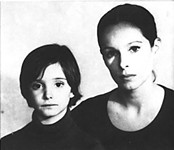
Goya in Bordeaux
1999, R, 98 min. Directed by Carlos Saura. Starring Francisco Rabal, Jose Coronado, Dafne Fernandez, Maribel Verdú.
REVIEWED By Marjorie Baumgarten, Fri., Nov. 17, 2000
Carlos Saura's portrait of the artist Goya as an old man is sumptuous to behold, although one will not leave the theatre with a much deeper knowledge and understanding of this great Spanish painter's career. This court painter and portraitist is considered by many to be the forerunner of modernism, as his style combined an earthy pictorial realism with a satiric subjective edge. Goya's contempt for many of his subjects shows through his brushstrokes. Living and working in the latter half of the 18th century and the first couple decades of the 19th, Goya was witness to the political and romantic intrigues of the last years of the Bourbon court and the Napoleonic invasions of Spain. This thumbnail background, however, is more historical information than the movie provides, and the film is unlikely to be of much interest to anyone who isn't already familiar with Goya -- or the work of Vittorio Storaro, the master cinematographer whose credits include Apocalypse Now, The Last Emperor, Dick Tracy, and most of the films of Bernardo Bertolucci. Goya in Bordeaux revels in Storaro's magisterial touch and lighting sorcery, which prove particularly apt when portraying the last years of Goya's life during which the painter lived in exile in Bordeaux and began painting dark and macabre subjects on the walls of his villa. The movie centers on the 82-year-old and deaf Goya (who is played as an old man by Rabal and as a young man by Coronado) reminiscing about his past to his young daughter Rosario (Fernandez). The paintings are used as entryways between the past and present, yet the information they convey is remarkably little. It's as if the noted director Carlos Saura had morphed into a Spanish-style Ken Russell, pursuing wild artist biopics that emphasize the lure of imagination over the pesky details of historiography. And, indeed, some of Saura and Storaro's imagery is extremely compelling: the film's dreamy opening sequence, for instance. But Saura's interest in recent years seems to have taken a particularly insular focus on the uniquely Spanish arts with films such as Tango, Flamenco, and Carmen in his repertoire. Unfortunately, his viewpoint does little to open up the subject for greater scrutiny, assuming as it does previous knowledge of the subject. Goya may be one of Spain's artistic touchstones, but he is an artist who belongs to the world also.
A note to readers: Bold and uncensored, The Austin Chronicle has been Austin’s independent news source for over 40 years, expressing the community’s political and environmental concerns and supporting its active cultural scene. Now more than ever, we need your support to continue supplying Austin with independent, free press. If real news is important to you, please consider making a donation of $5, $10 or whatever you can afford, to help keep our journalism on stands.
Goya in Bordeaux, Carlos Saura, Francisco Rabal, Jose Coronado, Dafne Fernandez, Maribel Verdú








